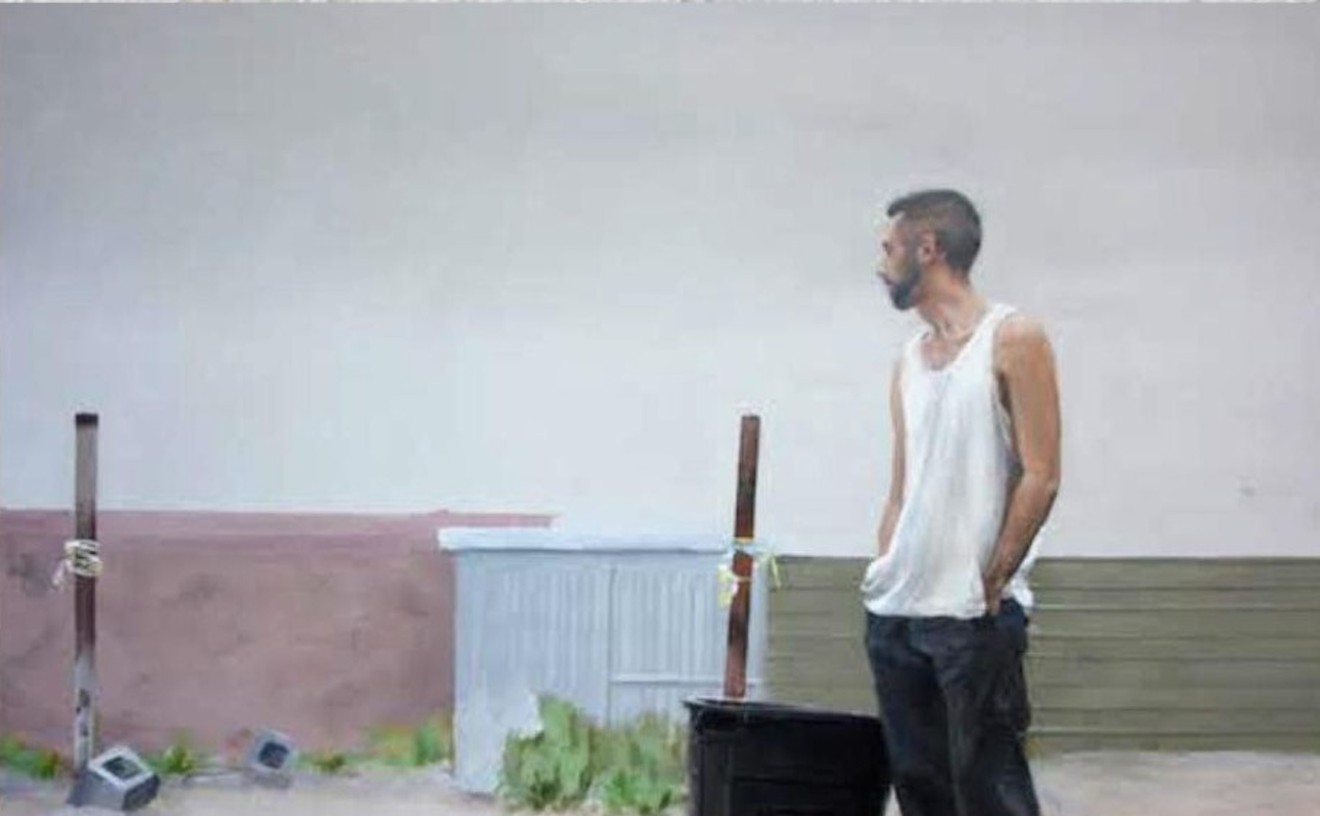For many years now, Phoenix artist Laura Spalding Best has been shifting the way locals view their urban landscape. Most notably, her mural depicting a half radius of power lines at an APS power station in Roosevelt Row reveals the inherent beauty of line in ubiquitous objects cluttering the landscape.
Typically, city dwellers fail to notice such things. But Spalding’s work gives viewers pause, not only while they’re encountering it, but long afterward as well.
Best achieves something similar with “Inferior Mirage,” an exhibition comprising three new bodies of work and including nearly 200 individual oil paintings on found objects. It’s named for a distorted reflection of the sky that sometimes appears like a distant body of water.
“Inferior Mirage,” which continues through November 27 at Chartreuse Gallery, explores the folly and hubris of constructed environments that usurp the power and wonder inherent in natural resources – especially water.
The exhibition includes 10 works Best calls "Hudson River School Marine Paintings" – each inspired by an actual painting from an American, mid-19th century art movement called the Hudson River School in which American landscapes were imbued with romanticism.
But the landscapes Best renders are fictional. Desert settings are awash in waves as if oceans had overwhelmed them, calling viewers to face the reality so much modern architecture and city planning fails to embrace: the scarcity of water in the Sonoran Desert.
Her Phoenix Yacht Club Regatta, painted after William Bradford’s 1856 New York Yacht Club Regatta, places a ship in a deep body of water, flanked by partially submerged power lines – revealing the absurdity of built-environments, such as artificial lakes, that strip the desert of its unique characteristics and charm.
They’re all oil paintings on metal surfaces. But some were actually painted on the back of stop signs, adding playful humor to the artist’s visual treatise on the complexities of contemporary water use.
“Inferior Mirage” also includes a body of work comprising chronological paintings, which capture actual desert landscapes encountered over time.
Night Oases #1-#12, a dozen oil paintings on three-inch diameter paint-can lids, channels shifting imagery along an urban roadway – in which evening ports of call such as chain stores are prevalent. It’s a beautiful reflection of myriad changes that typically go unnoticed, especially by those living hurried lives, and those more steeped in digital imagery than the landscapes of ordinary, everyday life.
For 25 Mile Companion, Best captures roadside images from travels through a portion of the Gila River Indian Community, in which her constant companion was a lone rain cloud that serves to mark the ways nature is ever-present but ever-shifting. The cloud is always with her, as she encounters a series of constructed objects that alter the ways humans relate to the land – including buildings, light poles, vehicles, and the utility lines so prevalent in Best’s larger body of work.
The images are painted onto 100 metal tags, arranged in 10 meticulous rows of 10 tiny paintings onto a 30-by-30-inch surface. The miniature paintings are hung on copper nails, rather than adhered to the surface, leaving them free to move – prompting reflection on the constant movement of water and sky.
The rain cloud is particularly poignant, signaling the fact that desert environments have their own water cycle independent of human attempts at intervention. It’s an homage, as well, to early Sonoran Desert dwellers who built the canals at the foundation of subsequent water use by those who settled the desert during western expansion.
Most spectacular is a gallery wall filled with 56 oil paintings on metal trays, comprising work which Best has titled Known Waterfalls of Greater Phoenix! Each painting depicts an artificial water source located in Phoenix, Tempe or Mesa. Again, her loose brush strokes serve as beautifully haunting indictments of humanity’s efforts to alter its surroundings to suit its own distorted images of paradise.
The trays conjure images of silver serving platters, arranged as if to form a vintage Victorian collection of family photographs or jeweled pins. It’s another subtle nod to human conventions that place barriers between humanity and nature, and the tendency of some to equate escaping the wild with achieving civilization and sophistication.
Best supplements these paintings with a printed four-panel handout that lists each faux-waterfall she’s rendered in this piece, and has a map showing where each one is located. In doing so, she returns her viewers from the romantic world of traditional oil paintings and longings for sentimental landscapes to the realities of everyday desert life – forcing them to confront the absurdity of seeking a deluge in the desert.
Through “Inferior Mirage,” Best offers compelling evidence of not only the folly of urban desert dwellers creating faux-environments, but also her own flourishing growth as an artist. Best continues to bring beauty, humor, and perspective to issues of water use in the desert, doing so in new and unexpected ways that make her work delightfully challenging, relevant, and captivating.
"Inferior Mirage" continues through November 27 at Chartreuse gallery. Best will give an artist talk at the gallery from 6:30 to 7 p.m. on Friday, November 18. Find more information on the Chartreuse gallery website.
[
{
"name": "Air - MediumRectangle - Inline Content - Mobile Display Size",
"component": "18478561",
"insertPoint": "2",
"requiredCountToDisplay": "2"
},{
"name": "Editor Picks",
"component": "16759093",
"insertPoint": "4",
"requiredCountToDisplay": "1"
},{
"name": "Inline Links",
"component": "17980324",
"insertPoint": "8th",
"startingPoint": 8,
"requiredCountToDisplay": "7",
"maxInsertions": 25
},{
"name": "Air - MediumRectangle - Combo - Inline Content",
"component": "16759092",
"insertPoint": "8th",
"startingPoint": 8,
"requiredCountToDisplay": "7",
"maxInsertions": 25
},{
"name": "Inline Links",
"component": "17980324",
"insertPoint": "8th",
"startingPoint": 12,
"requiredCountToDisplay": "11",
"maxInsertions": 24
},{
"name": "Air - Leaderboard Tower - Combo - Inline Content",
"component": "16759094",
"insertPoint": "8th",
"startingPoint": 12,
"requiredCountToDisplay": "11",
"maxInsertions": 24
}
]











